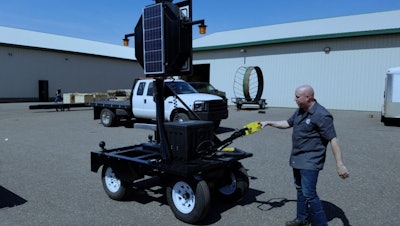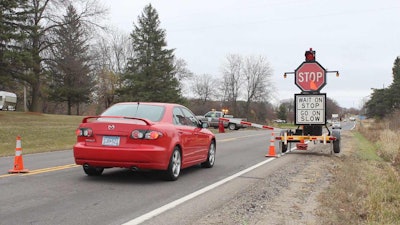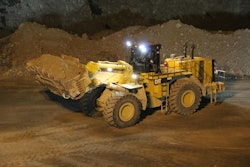 The moving automated flagger assistance device being field tested in Minnesota offers large electronic signage, lights and a traffic bar on a movable platform. The unit is clearly visible to road users and can be operated remotely from 400 feet off the roadway. Photo: MnDOT
The moving automated flagger assistance device being field tested in Minnesota offers large electronic signage, lights and a traffic bar on a movable platform. The unit is clearly visible to road users and can be operated remotely from 400 feet off the roadway. Photo: MnDOTWorking with a trailer manufacturer, a Minnesota research team has developed a moving automated flagger assistance device (AFAD) that signals traffic at work zones. Field testing on the well-received device continues as this construction season gets underway.
Minnesota Department of Transportation developed this Automatic Flagger Assistance Device (AFAD) for moving road work zones, such as pavement crack sealing operations.
The AFAD is operated remotely by a worker who can stand off the roadway, out of traffic, which helps reduce safety risks associated with being in the traffic flow.
The use of traditional AFADs in a moving operation can be difficult due to the towing requirements of the devices, so MnDOT had set out to find a solution to help reduce the well-known roadway risks to flaggers and road construction workers.
Evolving from a stationary AFAD to a mobile flagging device was key.
“In order to capture the benefits of AFADs in a moving work zone, the stationary AFAD needed to be modified to allow for self-propelled motion to follow the moving operation,” according to principal investigator Edward Terhaar with Wenck, a multi-state firm providing engineering, construction and other services.
“The AFAD is a one-of-a-kind device; we were able to basically start from scratch and come up with a device that meets all the needs it was designed for,” says Terhaar.
Distracted driving heightens risk for flaggers
With the increasing levels of distracted drivers, safety of flaggers and workers in work zones is an increasing concern coast to coast.
“Unfortunately, flagging personnel deaths and near misses continue to occur on our highways during each construction season,” Terhaar notes in his report.
By removing them workers from the traffic flow, the device could help reduce risk of injuries and fatalities to road construction workers. That critical need is now being spotlighted by National Work Zone Awareness Week, held April 9-13 to bring national attention to motorist and worker safety and mobility issues in work zones.
The leading cause of death in the road and bridge construction sector are run overs, back-overs and falls, according to the Federal Highway Administration’s Work Zone Management Program.
By 2014, Minnesota had already embraced the highly visible stationary device that effectively directs traffic in stationary maintenance and construction projects while keeping flaggers off the road, according to the agency.
MnDOT funded nearly $87,000 needed for the next step – developing this self-contained, self-propelled mobile AFAD for use on moving work zone roadway projects.
Developing a prototype
 Manufacturer DJ Products developed a prototype, then a new self-propelled AFAD at the company’s facility in Little Falls, Minnesota.
Manufacturer DJ Products developed a prototype, then a new self-propelled AFAD at the company’s facility in Little Falls, Minnesota.In 2015, researchers met with MnDOT engineers to identify the features needed in moving AFAD. The device, they decided, would need to be towable to a construction site with standard towing gear. It should be operable remotely through wired or wireless controls, movable in forward and reverse, and use rechargeable onboard batteries.
Researcher Terhaar, an expert in traffic engineering, reviewed existing devices already on the market to determine if a similar device was available and found no devices that met all the required needs.
The research team, in fact, investigated existing self-propelled devices from the United States, Canada and Australia for moving wheeled objects of all sizes to see if they could be adapted to these needs. No suitable device was found. The technical liaison for the research project was Thomas Dumont and project coordinator was Bruce Holdhusen, both from MnDOT.
After consultations with a technical advisory panel, the researchers contacted manufacturer DJ Products of Little Falls, Minnesota, which designs and manufactures devices for moving trailers, dumpsters, shopping carts and aircraft. Those include battery-powered devices.
Researchers met with DJ Products in February 2015. They reviewed the company products. And then they all agreed that DJ Products would develop a prototype vehicle on which the AFAD could be mounted.
In August 2015, DJ Products hosted a demonstration of the prototype vehicle, without the AFAD attached. The research team asked for modifications. Then, in April 2016, the company presented a new self-propelled device with the AFAD attached.
Field testing gets underway

In February 2017, a MnDOT operator field tested the mobile AFAD on a crack-sealing project on State Highway 71 south of Sauk Centre, west of Minneapolis.
The moving AFAD is operated with a wired or wireless controller, as well as with controls on a handlebar mounted on a vehicle.
Operators use one remote for moving the wheeled unit, and another remote from the original AFAD for the sign messaging. The new device moves forward and backward, can be towed with a standard hitch, and employs onboard batteries and a charger.
The moving AFAD can be operated by one person standing 400 feet or more off the roadway, and the device is big enough to be easily seen by drivers.. Though setup and take down require more effort than traditional flagging, that added effort is within reasonable limits – especially when compared with the safety benefits, according to the agency.
“Everybody who has used the mobile AFAD has liked it,” reports Jeremy Gjovik, transportation operations supervisor, MnDOT District 3, in a technical summary.
“We love our stationary AFAD unit. These units have really big stop-slow signs. They’re so visible.”
Moving AFAD features include remote operation
The device’s features include:
- Operated with wireless remote, wired remote, or handle controls
- Uses the original remote control from the AF-76 for the flagging components
- On-board batteries and battery charger
- Moves in forward and reverse directions at speeds up to 5 feet per second
- Towed to the work site using standard towing hitch
- Will operate for a minimum of 6 hours on initial charge
Field testing resumes this season to determine any modifications needed, MnDOT says.
To read more about the development and field testing of the new device, click here.










